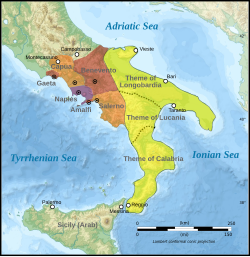
Byzantine Italy consisted of various parts of the Italian peninsula that were under the control of the Byzantine Empire since the Gothic War (535–554), and up to the end of the 11th century, with a brief attempt of Byzantine reconquest in the middle of the 12th century.[1]
Chronologically, it refers to:
- Praetorian prefecture of Italy (540/554–584)
- Exarchate of Ravenna (584–751)
- Theme of Sicily (687–902)
- Theme of Longobardia (c. 891 – c. 965)
- Catepanate of Italy (965–1071)

Several states avoided conquest by the Lombards or Franks and maintained nominal Byzantine allegiance even after the Byzantine presence in Italy came to an end:
- Byzantine Venetia (later: Republic of Venice)
- Duchy of Naples
- Duchy of Gaeta
- Duchy of Amalfi
- Duchy of Sorrento
Likewise, the island of Sardinia maintained Byzantine allegiance in this period:
See also
[edit]Wikimedia Commons has media related to Category:Byzantine rule in Italy.
References
[edit]- ^ Cosentino 2021, p. 1-25.
Sources
[edit]- Calaon, Diego (2014). "La Venetia maritima tra il VI e il IX sec. Mito, continuità e rottura" (PDF). Dalla catalogazione alla promozione dei beni archeologici. Venezia: Regione del Veneto. pp. 53–66.
- Cosentino, Salvatore, ed. (2021). A Companion to Byzantine Italy. Boston-Leiden: Brill.
- Gelichi, Sauro; Gasparri, Stefano, eds. (2018). Venice and Its Neighbors from the 8th to 11th Century: Through Renovation and Continuity. Leiden-Boston: Brill.
- Kreutz, Barbara M. (1996). Before the Normans: Southern Italy in the Ninth and Tenth Centuries. Philadelphia: University of Pennsylvania Press.
- Meyendorff, John (1989). Imperial unity and Christian divisions: The Church 450-680 A.D. Crestwood, NY: St. Vladimir's Seminary Press.
- Ostrogorsky, George (1956). History of the Byzantine State. Oxford: Basil Blackwell.
- Peters, Edward; Foulke, William D., eds. (2003) [1907]. Paul the Deacon: History of the Lombards. Philadelphia: University of Pennsylvania Press.
- Ravegnani, Giorgio (2006). Bisanzio e Venezia. Bologna: Il mulino.
- Skoblar, Magdalena, ed. (2021). Byzantium, Venice and the Medieval Adriatic: Spheres of Maritime Power and Influence, c. 700-1453. Cambridge: Cambridge University Press.
- West-Harling, Veronica (2020). Rome, Ravenna, and Venice, 750-1000: Byzantine Heritage, Imperial Present, and the Construction of City Identity. Oxford: Oxford University Press.
- Vicelja-Matijašić, Marina (2005). "Byzantium and Istria: Some Aspects of Byzantine Presence in Istria" (PDF). Acta Histriae. 13 (1): 185–204.
- Wickham, Chris (1981). Early Medieval Italy: Central Power and Local Society, 400-1000. Totowa, NJ: Barnes & Noble.